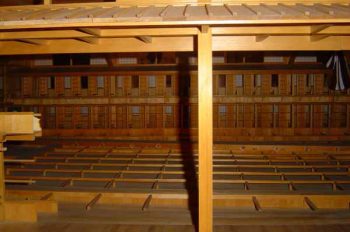Archive for 'Uncategorized'
Japanese Numbers 20 – 90 Posted by Ginny on Mar 15, 2009
In order to form the number 20 in Japanese, you add the number for 2 in Japanese with the number for ten. In the previous post I talked about how you need to add in order to form the numbers 11- 19. Well for the numbers 20 – 90 you need to multiply. If you…
Japanese Numbers Posted by Ginny on Mar 12, 2009
We’re going to learn how to count today! Here’s a run through of the numbers 0 -10: 0 – ree (れい) or zero (ゼロ) 1 – ichi (いち) 2 – ni (に) 3 – san (さん) 4 – yon (よん) or shi (し) or yo (よ) 5 – go (ご) 6 – roku (ろく) 7…
Japanese Culture: Kuromori Kabuki (くろもりかぶき) Posted by Ginny on Feb 10, 2009

Around February 15th in the city of Kuromori (くろもり) in Yamagata (山形) prefecture, the local people of Kuromori (くろもり) perform a kabuki (かぶき) play. The play is performed at the Hie jinja (日枝神社) or the Hie Shrine. It’s performed to honor the god that resides on Mount Hie (日枝). I always find these plays amusing…
Japanese Culture: Barentaindee (バレンタインデー) Posted by Ginny on Feb 9, 2009
Barentaindee (バレンタインデー) is the way Japanese people pronounce ‘Valentine’s Day’. It’s customary for Japanese people to give chocolates as a present on Valentine’s Day. In fact, it’s not only customary, in some ways it’s obligatory. Among co-workers, chocolates called giri choco (義理チョコ) are commonly distributed be female OLs (オーエル) to male co-workers. At this point…
Japanese Culture: Kenkoku Kinen no Hi (建国記念の日) Posted by Ginny on Feb 8, 2009
Kenkoku kinen no hi (建国記念の日) is a national holiday celebrated every year in February. When translated into English, kenkoku kinen no hi (建国記念の日) means ‘National Foundation Day’. Kenkoku kinen no hi (建国記念の日) is a day celebrating the creation of Japan as a nation under the emperor Jimmu (神武天皇). It’s a day of patriotism for many…
Japanese Thirst Quenchers Posted by Ginny on Feb 6, 2009
Sometimes when I throw a get together with friends and aquaintances, I have guests who arrive earlier than the others. To kill the time and be hospitable as well, I often place a bowl full of senbei (せんべい) with some tea. Senbei (せんべい) crackers can really make your throat dry, so it’s good to serve…
Japanese Food: Regional Munchies Posted by Ginny on Feb 5, 2009
Time for our Kyoodo Ryoori (郷土料理) series! For those of you who don’t know, kyoodo ryoori (郷土料理) means ‘regional specialites.’ Today we’re going to take a trip to Kamakura, Kanagawa (鎌倉, 神奈). Kamakura (鎌倉) is a city steeped in history. Before Tookyoo (東京) became the capital city of Japan, Kamakura (鎌倉) was the foremost prosperous city…


